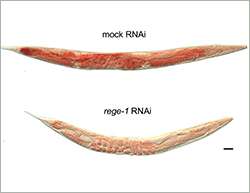Molecular mechanism controlling fat accumulation elucidated

Scientists in Rafal Ciosk's group at the FMI have identified a novel regulator of fat accumulation in the nematode C. elegans. An RNase, REGE-1, degrades the mRNA encoding a fat loss promoting transcription factor, ETS-4. The RNase and the transcription factor form an autoregulatory module controlling fat metabolism.
Since the 1980s, the prevalence of obesity worldwide has more than doubled. Today, almost 2 out of 5 adults are overweight. In addition, overweight and obesity are known to be major risk factors for cardiovascular and musculoskeletal diseases, diabetes and some cancers. What is less well understood are the molecular mechanisms controlling fat accumulation or metabolism.
Rafal Ciosk's group at the Friedrich Miescher Institute for Biomedical Research (FMI) has now identified a novel player in fat regulation – an RNase. RNases are enzymes that promote the degradation of RNAs. Most interestingly, they remove RNA that is no longer needed, thus playing an important role in post-transcriptional regulation.
The scientists showed that, in C. elegans, a previously uncharacterized RNase, REGE-1, promotes the accumulation of body fat by degrading the mRNA that encodes a fat-loss-promoting transcription factor, ETS-4. First author Cornelia Habacher, a PhD student in the Ciosk lab, comments: "This is the first instance where fat metabolism is post-transcriptionally regulated by an RNase. We knew of a couple of microRNAs that targeted certain RNAs in fat regulation, but an RNase is new." Once ETS-4 mRNA is degraded, its effects are lost and fat accumulates in these worms.
The scientists also showed that ETS-4, in turn, induces REGE-1 transcription. Ciosk explains: "REGE-1 and ETS-4 appear to form an autoregulatory module. We believe this type of fat regulation is important when an organism needs to rapidly adapt its fat metabolism – for example, when faced with an environmental change."
More information: Cornelia Habacher et al. Ribonuclease-Mediated Control of Body Fat, Developmental Cell (2016). DOI: 10.1016/j.devcel.2016.09.018
Journal information: Developmental Cell





















